
Faculty Research 1990 - 1999
Embryonic phenotype of Unc5h3 mutant mice suggests chemorepulsion during the formation of the rostral cerebellar boundary.
Document Type
Article
Publication Date
1998
Keywords
Brain-Stem: cy, Cell-Movement, Cerebellum: em, me, Fetal-Development, Gene-Expression-Regulation-Developmental, Immunohistochemistry, In-Situ-Hybridization, Mesencephalon: em, Mice, Mice-Transgenic, Mutation, Nerve-Growth-Factors: ge, me, Neurons: cy, Phenotype, Purkinje-Cells: cy, Receptors-Nerve-Growth-Factor: ge, me, Signal-Transduction, Stem-Cells: cy, SUPPORT-U-S-GOVT-P-H-S
First Page
41
Last Page
50
JAX Source
Development 1998 Jan;125(1):41-50
Grant
NS35900/NS/NINDS, CA37225/CA/NCI, CA34196/CA/NCI
Abstract
Mutation of the Unc5h3 (formally known as rcm) gene has important consequences on neuronal migration during cerebellar development. Unc5h3 transcripts are expressed early (embryonic day 8.5) in the hindbrain region and later in the cerebellar primordia. In Unc5h3 mutant embryos, both the development and initial migration of Purkinje cell progenitors occur as in wild-type controls. The rhombic lip, from which granule cell precursors arise, also appears to form normally in mutants. However, at E13.5, an abnormal subpopulation of granule cell and Purkinje cell precursors becomes detectable in rostral areas of the Unc5h3 mutant brain stem. These ectopic cerebellar cells increase in number and continue moving in a rostral direction throughout the remainder of embryogenesis and early stages of postnatal development invading the lateral regions of the pontine area and eventually the inferior colliculus. Cell proliferation markers demonstrate the mitotic nature of these subpial ectopic granule neurons indicating the displacement of the rostral external germinal layer in mutant animals. Our data suggest that establishment of the rostral cerebellar boundary may rely on chemorepulsive signaling events that require UNC5H3 expressed by cerebellar neurons and extracellular ligands that are functionally related to the UNC5H3-binding, guidance molecule netrin1. Although the phenotype resulting from the Unc5h3 mutation is apparently limited to the formation of the cerebellum, additional sites of Unc5h3 expression are also found during development suggesting the compensatory function of other genes.
Recommended Citation
Przyborski SA,
Knowles BB,
Ackerman SL.
Embryonic phenotype of Unc5h3 mutant mice suggests chemorepulsion during the formation of the rostral cerebellar boundary. Development 1998 Jan;125(1):41-50

